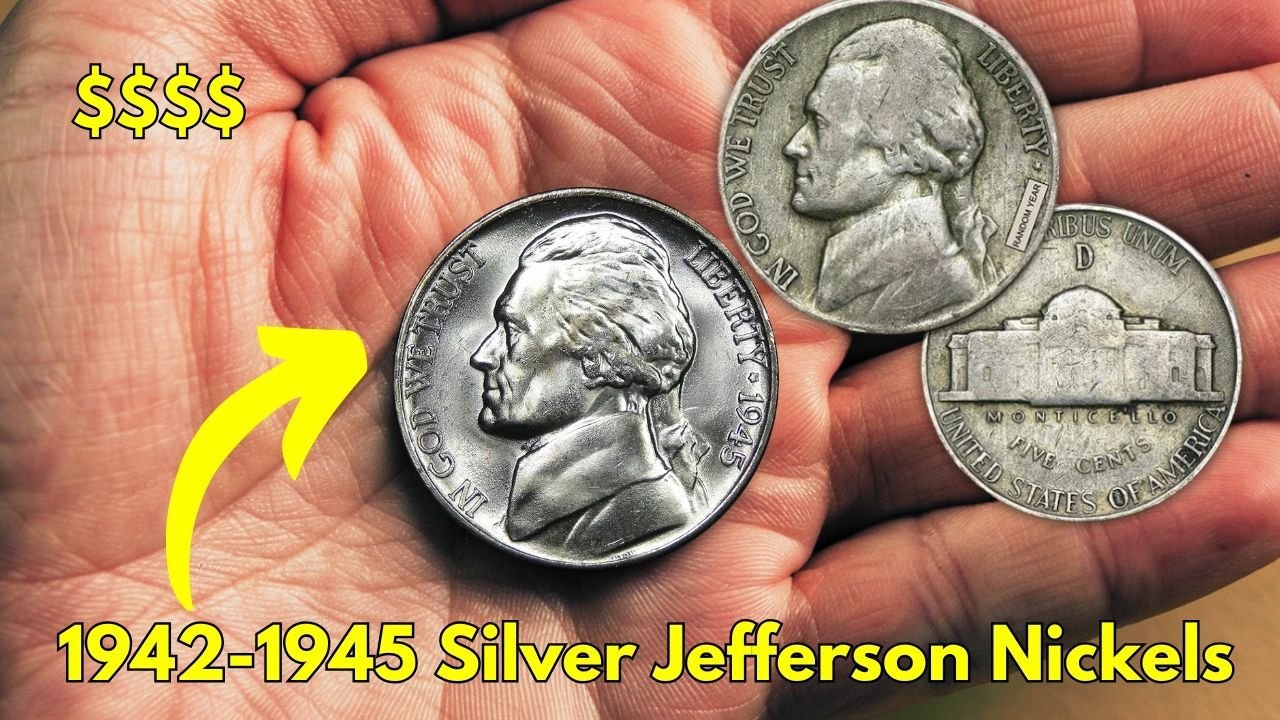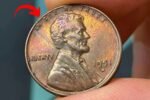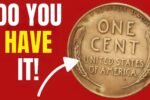1942-1945 Silver Jefferson Nickels Are Surging in Value – Here’s Why
Jefferson Nickels have been part of American coinage since 1938. They are well-known for featuring the portrait of Thomas Jefferson on the front and his Monticello home on the back. But not all Jefferson Nickels are equal. Some of them, especially those minted between 1942 and 1945, are now gaining attention and rising fast in value. These special nickels are not made entirely from the usual copper-nickel alloy — instead, they contain silver. Let’s explore why these silver nickels are becoming a hot topic among collectors and investors.
What’s So Special About 1942-1945 Jefferson Nickels?
During World War II, nickel was needed for the war effort. The U.S. government made a major decision — to change the composition of nickels for a few years. From mid-1942 to the end of 1945, Jefferson Nickels were made from a special alloy that included 35% silver, 56% copper, and 9% manganese.
This temporary change made these coins quite different from other nickels. And now, as silver prices rise and coin collecting becomes more popular, people are rushing to find and collect these wartime nickels.
Why Are Silver Jefferson Nickels Gaining Value Now?
There are several reasons behind the surge in value of these coins:
-
Silver Content – Since these nickels contain real silver, they have intrinsic metal value. As silver prices go up, so does the base value of these coins.
-
Historical Significance – These coins were produced during a critical time in U.S. history. Many collectors are drawn to World War II-era items, and these nickels are an affordable way to own a piece of that history.
-
Collectibility – Not all wartime nickels are easy to find in good condition. Uncirculated or high-grade examples are especially valuable.
-
Mint Marks and Rarity – Some of the silver nickels, like those from the San Francisco (S), Denver (D), and Philadelphia (P) mints, are more sought after. These coins even have large mint marks above Monticello on the reverse side — the only time a “P” mint mark was used until 1980.
Overview Table: Key Features of 1942-1945 Silver Jefferson Nickels
| Year | Mint Mark | Composition | Minted Quantity (approx.) | Special Notes |
|---|---|---|---|---|
| 1942-P | P | 35% Silver, 56% Copper, 9% Mn | 57 million | First year of silver nickels |
| 1943-D | D | 35% Silver, 56% Copper, 9% Mn | 15 million | One of the rarer years |
| 1944-S | S | 35% Silver, 56% Copper, 9% Mn | 21 million | San Francisco wartime issue |
| 1945-P | P | 35% Silver, 56% Copper, 9% Mn | 119 million | Final year of silver nickels |
| 1943-P | P | 35% Silver, 56% Copper, 9% Mn | 271 million | Highest production year |
How to Identify a Silver Jefferson Nickel
Spotting a silver wartime nickel is not hard, once you know what to look for:
-
Date Range: Only coins from mid-1942 to 1945 are silver.
-
Mint Mark: Look for a large mint mark (P, D, or S) above the Monticello building on the reverse. Regular nickels have the mint mark next to the building or no mint mark at all.
-
Color: These nickels often have a duller, grayish tone compared to regular nickels.
If you find one of these in your change or old coin collection, it might be worth a lot more than face value.
Are These Coins Worth Collecting or Investing In?
Absolutely — especially if you’re just getting into coin collecting. Wartime Jefferson Nickels offer an affordable entry into precious metal coinage. Many of them are still available in circulation or old jars of coins. Their historical background makes them interesting conversation pieces, and the silver content gives them long-term value.
For serious collectors, high-grade coins that have been professionally graded by services like PCGS or NGC can fetch hundreds of dollars, especially those with full steps on Monticello (a grading term referring to strong strike quality).
Tips for Collecting Silver Jefferson Nickels
-
Check your change: These coins are still occasionally found in circulation.
-
Look for high condition coins: Coins with less wear will be more valuable.
-
Use a magnifying glass: This helps in spotting mint marks and checking the coin’s details.
-
Consider grading: If you think you have a rare or very well-preserved coin, professional grading could increase its resale value.
FAQs: Wartime Silver Jefferson Nickels
Q1: What is the melt value of a silver Jefferson Nickel?
A1: It depends on the current silver price, but generally, each coin contains about 0.056 ounces of silver. At $25 per ounce, that’s about $1.40 in silver.
Q2: Are all 1942 Jefferson Nickels silver?
A2: No. Only those minted after mid-1942 are silver. Early 1942 nickels were still the regular copper-nickel alloy.
Q3: Can I still find these nickels in circulation?
A3: Yes, though it’s rare. Some still turn up in everyday change, especially in coin rolls.
Q4: Which silver Jefferson Nickel is the rarest?
A4: The 1943-D is among the lower mintage wartime nickels and can be harder to find in top condition.
Q5: Do these nickels tarnish or change color over time?
A5: Yes, due to their silver content, they can develop toning or a patina, which sometimes makes them more appealing to collectors.
Conclusion:
The 1942-1945 Silver Jefferson Nickels are more than just pocket change. They’re a small but fascinating piece of American history that also holds real silver value. Whether you’re a beginner collector, a seasoned hobbyist, or someone looking to invest in silver, these nickels offer a smart and historical way to start. So next time you see an old nickel with a big mint mark above Monticello, take a closer look — you might just be holding something special.














